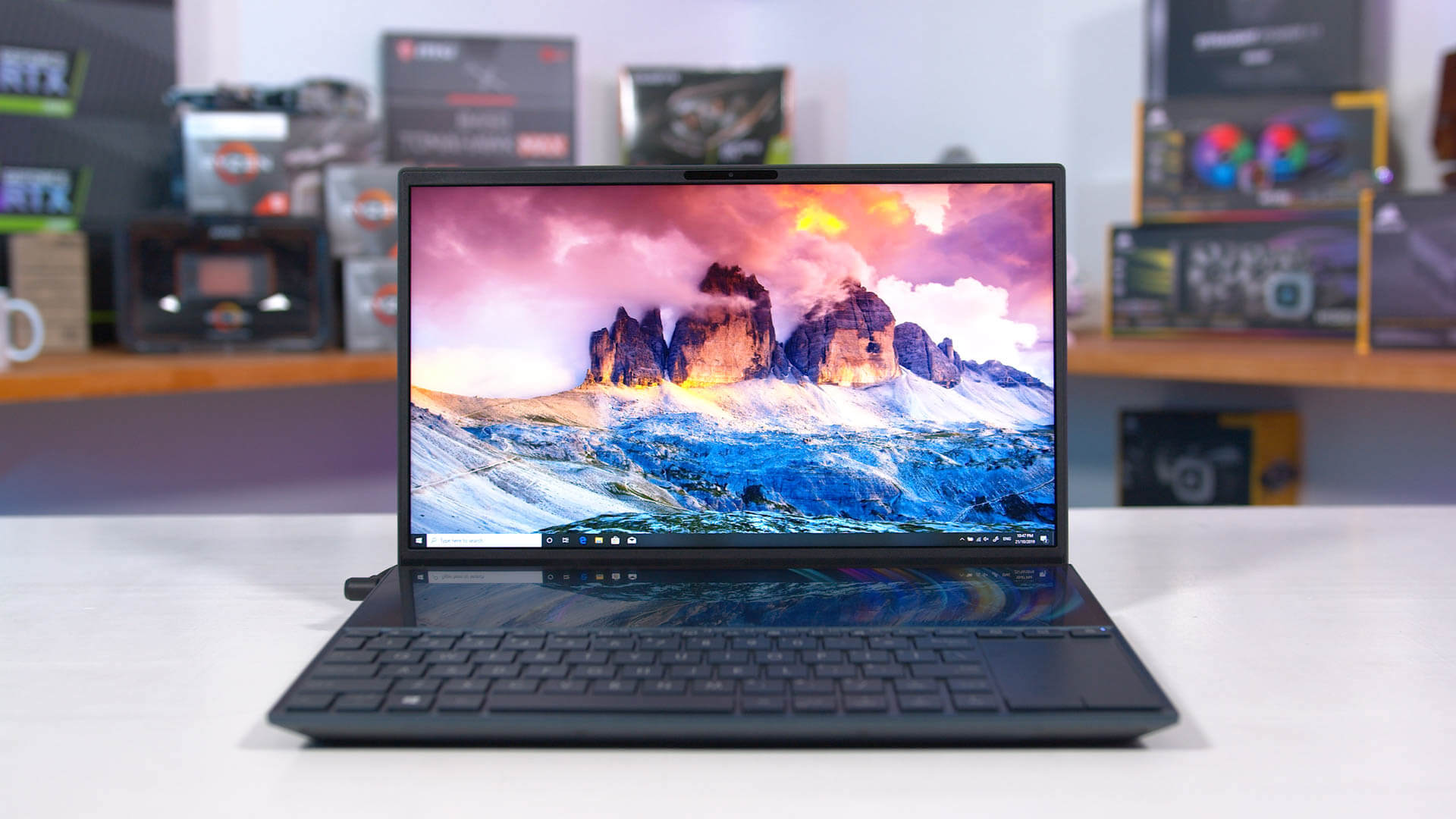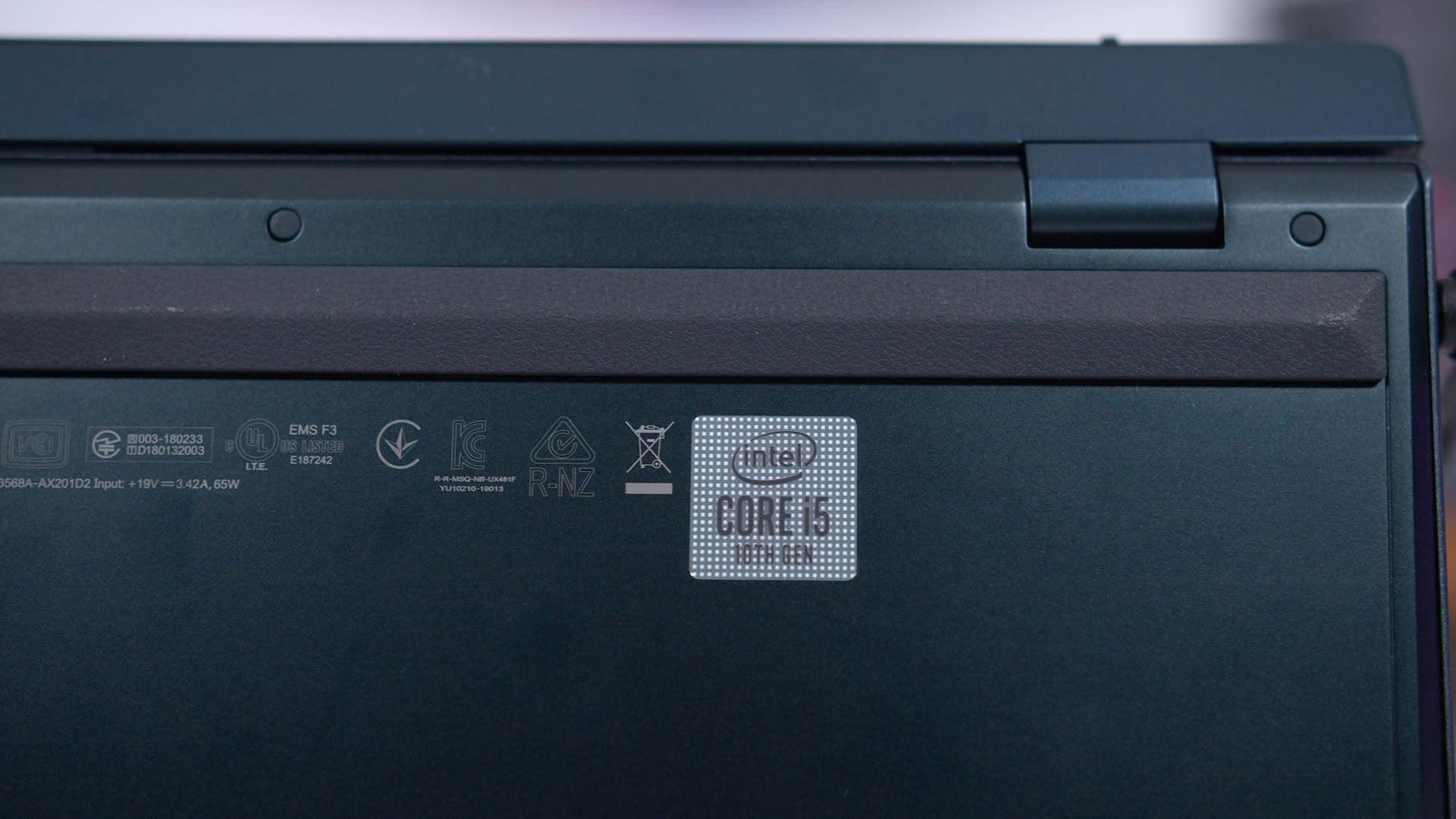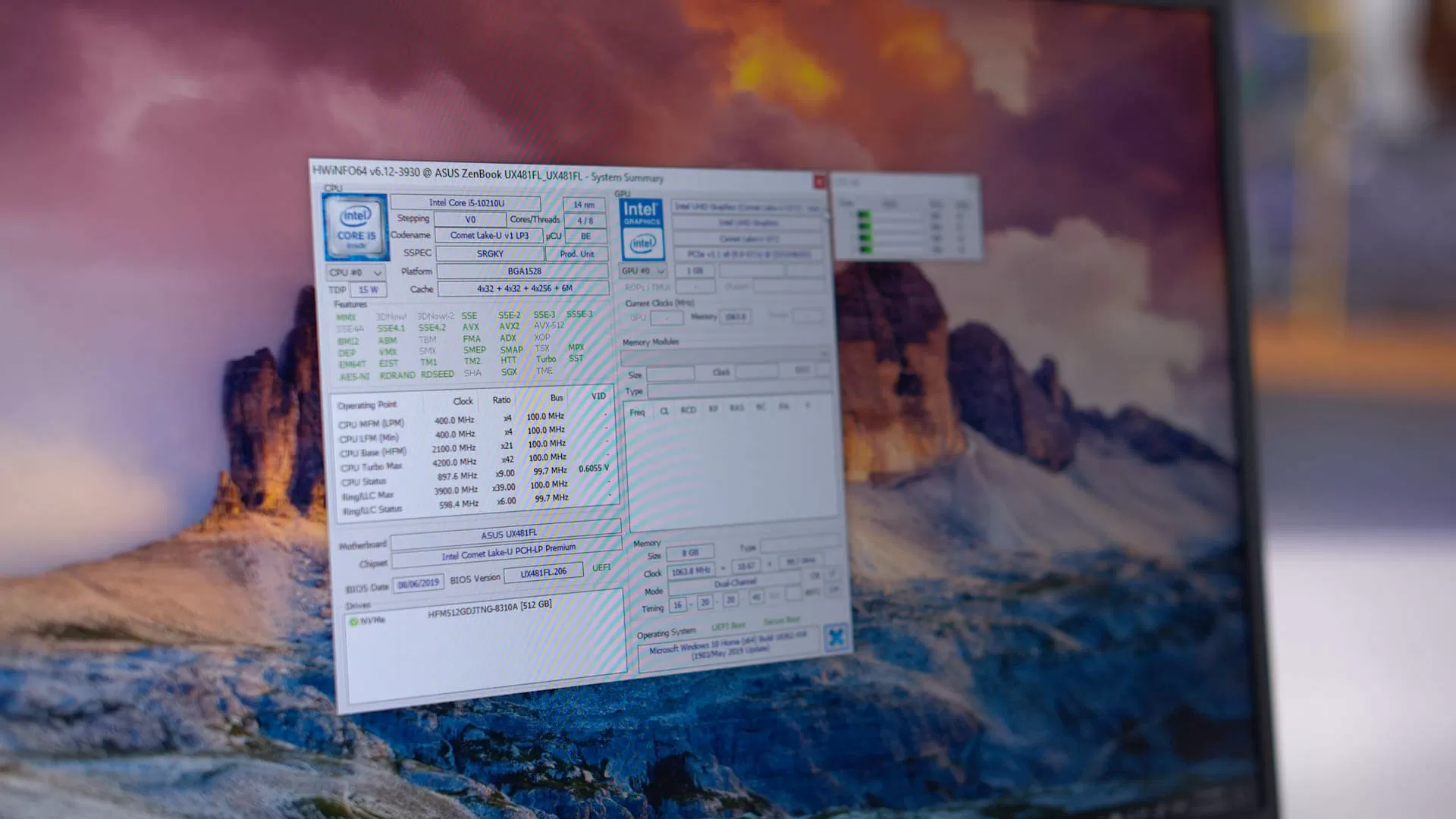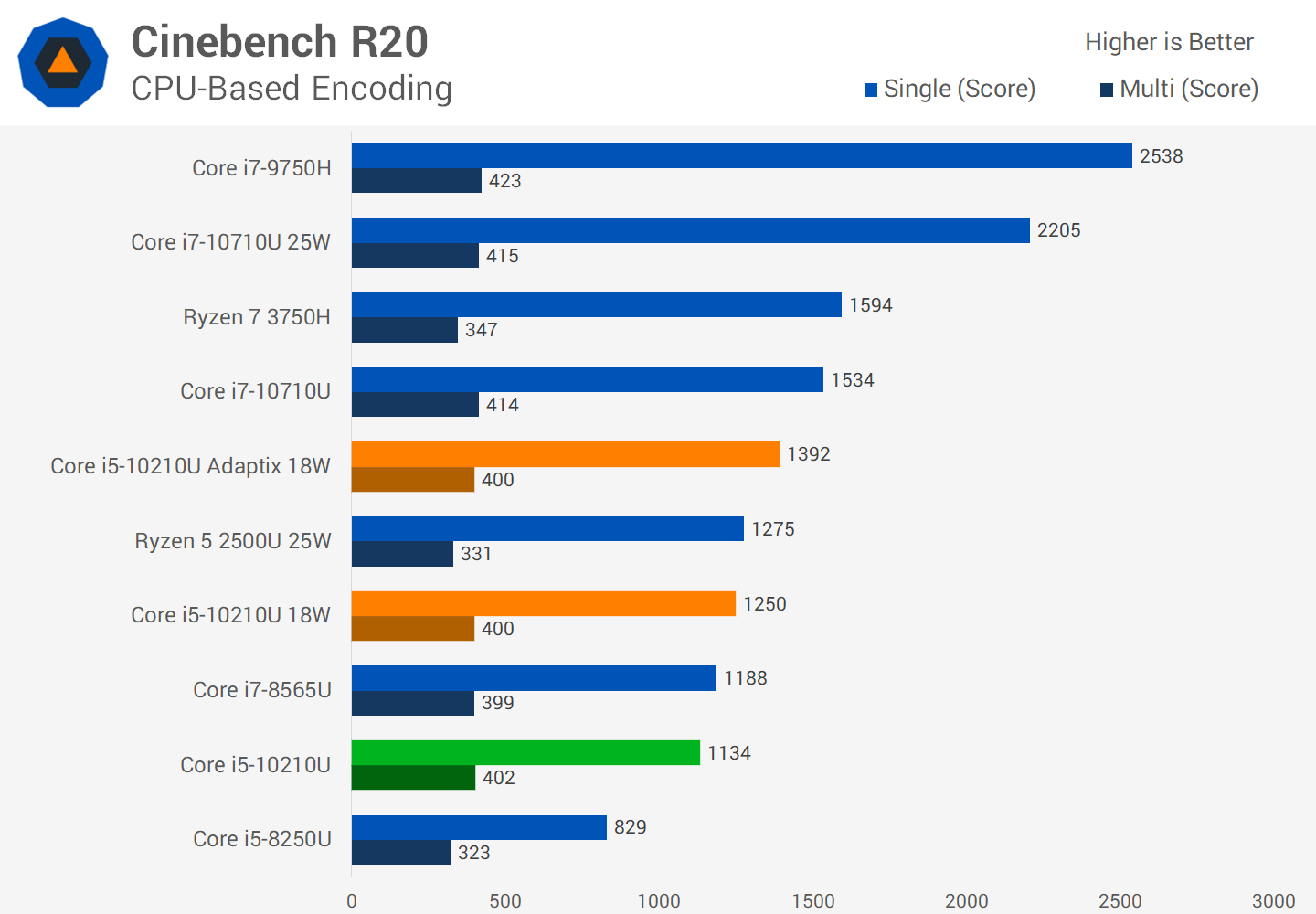Hp 17-x116dx - 173 - Core I5 7200u Professional Reviews
We were pleasantly surprised recently when we looked at the Core i7-10710U. This was the first demonstration of what Intel can still do on 14nm to squeeze more than performance. The 10710U packs six cores and twelve threads into a 15W packet. Even though this CPU runs beneath 2.0 GHz in long term tests to become all those cores working inside such a tight TDP, it still managed to deliver upwards to xxx% more performance than 8th-gen CPUs.
This is down to Intel optimizing the efficiency signal of this CPU. By reducing clock speeds slightly, Intel gained enough power budget to add in two extra cores, and these 2 cores more than commencement the reduction in clock speed, giving us more performance in multi-threaded workloads. It makes the CPU design more complex and expensive and the gains are only present in workloads that use more than iv cores, but in that location'southward no doubt the gains are at that place.

Today nosotros're checking out another 10th-generation Intel CPU, and like the last one, this chip is much more interesting than it appears at face value. You'd remember that with these 14nm+++ CPUs Intel has basically nix left in the tank, only even with the quad-core we're reviewing today, that's surprisingly far from the truth.
The aforementioned i7-10710U is the only CPU in Intel's new 10th-gen line-up that has vi cores. The residue are quad-cores, or even dual-cores if we go down to the Core i3s, Celerons and Pentiums. The Core i7-10510U, for example, is a four cadre eight thread CPU but it's clocked a decent amount higher than the six-cadre 10710U, with its ane.eight GHz base of operations clock and four.nine GHz maximum turbo clock. This is higher than any Whiskey Lake CPU too, especially the popular Cadre i7-8565U, which is clocked up to 300 MHz lower.
So nosotros go to the CPU nosotros're reviewing today, The Intel Core i5-10210U sports four cores and 8 threads, but with a few reductions compared to the Core i7 models. Clock speeds are lower, at a 1.6 GHz base clock and maximum single core turbo of 4.2 GHz.

That's a footling college than the equivalent concluding-gen Cadre i5 on the maximum turbo speed, but not hugely different. Similar story with the all-core turbo, which sits with the 10210U at 3.9 GHz, up from 3.7 GHz. With both of these clocks, we aren't quite at the level of the Cadre i7-8565U, merely mostly speaking, for a 15W processor we are power limited rather than clock limited and that's something nosotros'll explore throughout the review.
The other important factor here is the L3 cache size, which drops down from 8 MB to 6 MB as with previous Core i5 models, with unified admission beyond the aforementioned number of cores. On a less of import annotation, the GPU remains the same, a UHD 620 with 24 execution units. Information technology'southward clocked l MHz lower on the Core i5 compared to by Core i7s, but what you should know is this is simply a serviceable GPU that's barely inverse from when Skylake U-series CPUs launched all those years ago.

Equally nosotros mentioned in our previous tenth-gen Core review, Intel hasn't made it like shooting fish in a barrel for the boilerplate laptop buyer to figure out which CPU they are getting and at what performance level. Comet Lake, the line-up we've but been talking about, exists alongside Water ice Lake on 10nm. Ice Lake CPUs are limited to quad-core designs at lower clock speeds on the CPU, but accept beefier integrated graphics with up to 64 execution units. Customers later on the best CPU operation should be on the look out for Comet Lake, while those that need amend GPUs might exist more interested in Ice Lake.
The naming scheme is simply unfriendly though. The Comet Lake Core i5 fleck we are reviewing today is the Cadre i5-10210U. While Water ice Lake Core i5s get names similar Core i5-1035G1 or Cadre i5-1035G7, depending on the graphics configuration. In that location'southward likewise the Core i5-1030G4 and G7 at 9W rather than 15W, further muddying the waters. This really needs to exist simplified.
Combine this with the fact that many laptops also come with depression-ability discrete GPUs to beef upwardly graphics functioning. So grabbing an Water ice Lake laptop might non even deliver the best GPU experience, relative to a Comet Lake product with a detached GPU.

Moving on, y'all will desire to know Comet Lake comes with a few boosted features compared to previous-gen products, so it isn't a simple refresh with different clock speeds. We're at present getting support for retention upwardly to DDR4-2666 speeds or LPDDR4x-2933, as well as native Wi-Fi 6 support. Simply the bigger improvement comes in the class of something called Intel Adaptix, which we didn't cover in our Core i7-10710U review equally information technology wasn't enabled on the laptop we tested.
Adaptix is a feature new to non just Comet Lake, but 10th-gen CPUs in general, so right at present this also includes Ice Lake. It's a new version of Intel's dynamic tuning technology that takes turbo boosts a step further than we've seen previously in a mobile form factor.
Before, with Intel's 8th-gen CPUs y'all would go two power limits: PL1, which is the long term power limit, and PL2, the brusk term limit for turbo boost. When a workload gets fired up, the CPU would bound upward to PL2 for a predetermined amount of time, then cut dorsum to PL1 when that fourth dimension is upwards. Then on a 15W laptop, that would typically be a heave up to 45W for a few seconds with higher clock speeds, then a drib straight down to 15W for the rest of the workload.

Intel Adaptix changes this. Instead of dropping down to the sustained PL1 limit, Adaptix adjusts the PL1 limit dynamically over time to maximize performance based on the limits of the organization. These limits are typically thermal constraints. This could encounter the system run at in a higher place the long term PL1 limit for a much longer fourth dimension because the thermal limit of the system hasn't been reached.
In some means, the old system was leaving a lot of potential performance on the table. If the organization dropped down to PL1 well earlier the cooler had heated upwardly to its sustainable limit, information technology could have boosted for longer to accomplish the limit sooner, before then dropping down. Adaptix is aimed at solving that problem and Intel says it delivers viii-12 percentage more performance. However, Adaptix is optional and requires a lot of profiling on the OEM side, so it'south merely enabled on some systems.
Our Core i5-10210U examination platform is Adaptix enabled, and it'south none other than the new Asus ZenBook Pro Duo.

This is an interesting laptop to test every bit information technology comes with a second screen above the keyboard. We've been using this laptop for the last few weeks. For the stuff we usually do on a laptop like web browsing, spreadsheet editing and then on, the 2d screen isn't all that useful merely for some people, having information technology at that place could exist handy. It's a very unique design and overall the laptop is very portable, plumbing fixtures into a 14-inch form factor.
The verbal model we have on hand is the ZenBook Pro Duo UX481FL. It uses a 14-inch 1080p brandish, the Core i5-10210U processor, GeForce MX250 graphics, and 8GB of DDR4 retentiveness. You can get up to Core i7 CPUs and 16GB of RAM in hither, although information technology's dainty to encounter the MX250 is retained for the Cadre i5 model. For the purpose of testing the i5-10210U thoroughly though, we've benchmarked with both the MX250 enabled and disabled.
Benchmarks
Nosotros're going to boot this one off with a wait at Cinebench R20. First, let'due south rapidly run through the configurations we have here. This is the standard Core i5-10210U running with Adaptix manually disabled, in a standard 15W configuration. This gives the states an apples-to-apples comparison with other U-series CPUs, which are configured to 15W here equally well unless otherwise specified. This is what a typical buyer can expect from a 10210U laptop where Adaptix is not used.
Then we have two 18W configurations, 1 with Adaptix enabled, and some other without. The reason we've configured information technology up to 18W here, is that the ZenBook Pro Duo comes by default with a long-term PL1 limit of around 17 to 19W, hovering between that mark with Adaptix enabled out of the box. We can then manually limit the CPU to a PL1 of 18W using the Intel Extreme Tuning Utility, and that gives us a look at the operation do good we're getting from Adaptix specifically, and whether or not it's worth finding laptops with this optional feature enabled.

The first matter to note is that this 10th-gen Comet Lake Core i5 is not far away from Intel's 8th-gen Whiskey Lake Cadre i7 in the i7-8565U. We're only about 4 percent behind and faster in the single-threaded exam, which is impressive from a mid-range Core i5. However, comparison Core i5 to Core i7 in the 10th-generation, and the Core i5 is 23 percentage slower, so those extra two cores you get with the 10710U are a significant improver for this type of workload.
We're besides getting a proficient look at Intel's Adaptix technology. In this criterion, having Adaptix enabled is delivering an xi% performance improvement from being able to boost that flake college in this medium-term exam.

Nosotros can see above what'due south happening to clock speeds with a await at Cinebench R20. Without Adaptix, the 10210U performs every bit nosotros've always seen from Intel mobile CPUs. We get a curt menstruum boosting into the PL2 state, this time clocked around 3.vii to iii.nine GHz which is expected given this CPU'due south maximum all-core turbo frequency. So it drops downwards and maintains a consequent clock during PL1, which is around 2.5 GHz configured at 18W, or two.iii GHz at 15W.
With Adaptix enabled, the nautical chart looks very different. Nosotros still get that boost period right at the start, simply immediately later on that, instead of dropping right downwards to PL1, clock speeds gradually autumn away and only one-half fashion through the test do nosotros see them reach the long term limit of about 18W, delivering ii.5 GHz all-core. Then for more than half this test nosotros're benefitting from clock speeds over a GHz higher in some situations, as we're running closer to the thermal limits.
There'southward no guarantee that this clock speed behavior volition be the same for all Adaptix laptops, in fact, we can near guarantee there there will be variations depending on the cooling capabilities. This Asus laptop seems to have strong cooling, and so this is probably a best case scenario.
Looking at the older Cinebench R15, nosotros're getting an even higher performance heave from Adaptix. This is because Cinebench R15's multi-threaded test is quicker to run, so even more than of the benchmark run occurs during a boost stage. This gives the 10210U very impressive results, nearly matching the 10710U.

Something else to notation, the boost in performance you become from Intel'due south Adaptix technology will depend on how you are using your system or how the workload is configured. If your system is idle before running a sure CPU intensive task, you'll go the biggest benefit, and might see even bigger gains than nosotros're showing here. If you've been doing a few moderate tasks, yous'll go a moderate improvement, and if you've only been smashing your CPU at 100% utilization, information technology'southward unlikely you'll see any gain. For these benchmarks we perform an average of 3 runs back to back, then the first run tends to produce a higher score with Adaptix enabled than the successive runs. Generally our numbers represent a 'mixed' utilise example where y'all may go from doing ane matter, straight into another, with some small periods of idle in between.
In longer workloads, the benefits of Adaptix are reduced. Here we accept x264 encoding, and we're only getting a six% operation gain in pass 1, and only 2 per centum in pass 2. When the CPU falls back to long term limits, there'southward no difference in clock speeds and thus no difference in performance between the two modes.

That said, in this benchmark it'southward squeamish to run into the i5-10210U and i7-8565U providing about the aforementioned performance. The new six-core model takes things up a notch over again with this tenth-gen line-up, only getting last year'due south Core i7 performance in this year's Core i5 is not bad at all.
Like story in Handbrake, although this test is very limited by the 15W TDP of these CPUs. The i5-10210U is about 5% behind concluding year's 8565U, but also five% faster than Intel's Cadre i5 from ii generations agone. For farther gains in Handbrake you need more cores or a higher TDP.

In vii-zip, the i5-10210U is marginally ahead of the Core i7-8565U in decompression and marginally behind in compression, so trading blows with final-gen's Core i7. Adaptix provides a small boost, 8 percentage in decompression and 4 percent in compression, which again is also decent. A Core i5-10210U laptop with Adaptix enabled will easily beat Intel's last-gen offerings if configured to similar long term PL1 TDPs, not but in this exam but also in general.

PCMark 10 is a drove of shorter workloads and unmarried threaded stuff, but the 10210U does pretty well here, clocking in 6 percent faster, like to what nosotros saw with 7-null, another shorter workload.

In Adobe Photoshop Iris Blur we're seeing the 10210U perform effectually the same level as the 8565U, in what is a shorter CPU limited benchmark. Adaptix is very impressive here, also, providing an additional 12 percent, which is ane of the better results and non surprising given the test takes nether 30 seconds. Once again, we're right in that ballpark estimate Intel gave almost Adaptix providing 8 to 12 percent more than functioning.

Adobe Premiere with Lumetri furnishings is a more compute heavy criterion, and one where the Cadre i5-10210U is slower than the Core i7-8565U by about 10 percent, which is one of the larger margins we've seen and then far. Some of this volition exist down to CPU performance, the rest will be from the slight downclock on the GPU, given this benchmark really benefits from a faster GPU. We can see that from calculation an MX250, the 10210U completes the render three times quicker, which is why those editing Premiere will want to source a laptop that has a discrete GPU.

In Adobe Photoshop Smart Acuminate, no real difference between CPUs that characteristic Intel's UHD 620 GPU. This is a GPU limited test, so without any improvement in GPU going from 8th-gen to tenth-gen, we're stuck here with weak functioning.

Blender is another criterion where the Core i5-10210U comes close to the Core i7-8565U, merely ultimately falls simply short, coming in about 3 percent slower. It is, however, much faster than Intel's Core i5-8250U from two generations agone, and Adaptix provides an additional 7 percent in this test if it's enabled.

It'southward no surprise to see not much of a operation proceeds in MATLAB, unless we're comparing this generation to several generations ago.

And finally we have a expect at GPU operation once more with CompuBench Optical Flow, which again shows the limitations of Intel's integrated graphics. You'd desire something with an MX250 inside to get much better GPU and compute performance, or maybe a Ryzen APU will exist tempting.

Performance Breakdown
Core i5-10210U vs. Cadre i7-8565U
As yous may accept noticed by our numerous mentions throughout the review, for united states of america the most telling comparison is the i betwixt the Core i5-10210U and the Core i7-8565U. They evangelize about even performance on average, and so it's somewhat prophylactic to say that when both CPUs are configured to 15W, Intel's 10th-gen Cadre i5 performs like an eighth-gen Whiskey Lake Core i7.

With Intel opening a new product category for Comet Lake Core i7s, now offering half dozen cores, information technology seems they take pushed what used to be Cadre i7 operation, down to the Core i5 tier. We dear to run into this sort of improvements year on year and faster CPUs hit more mid-range products. Unfortunately nosotros haven't reviewed any Whiskey Lake Cadre i5, and then the best Core i5 comparison nosotros have is the Core i5-8250U from Kaby Lake-R two years ago. Yet, this remains a highly relevant comparing considering just a minority will be upgrading their machine later on a year of utilize.
Core i5-10210U vs. Cadre i5-8250U

In this case we're seeing a 20 percent improvement on average, which is impressive after merely ii years. Nigh of this is down to clock speeds and process refinements, only once again, getting Cadre i7 operation from a Core i5 is basically the result here. And it's possible to push button those gains further if you tin can find a laptop that supports Adaptix technology.
Core i5-10210U: Adaptix on vs. off
Nosotros recorded a v-6% percent functioning gain from this characteristic on average, although this will depend on the workload. If we're comparison an Adaptix-enabled i5-10210U to any of Intel's eighth-gen U-series models, nosotros're looking at a small but significant operation gain given this is a mainstream oriented Core i5 CPU.

Core i5-10210U vs. Core i7-10710U
Compared to the new six-core Core i7 over this quad-core Cadre i5. The i5 is nigh 17 pct slower on average, which is a similar gap to what we saw comparing Core i5 to Core i7 with Kaby Lake Refresh. Back then, the difference was due to clock speeds, at present it'south down to core counts, and so a shift in thinking here from Intel to permit them to continue the life of 14nm.

Core i5-10210U vs. Ryzen v 2500U
When tossing up Core i5 versus Ryzen 5, there'due south a big operation advantage in CPU limited tasks for Intel'south 10th-generation CPU. Yes, this is the 2500U not the newer 3500U, but the 3500U is only clocked 100 MHz higher which isn't going to shut the operation gap. The Ryzen 2500U does have a much faster integrated GPU.

However if you tin can observe a Core i5-10210U paired with an MX250, generally this volition be all circular faster than a Ryzen 5 arrangement, especially in workloads like Premiere which stress the CPU and GPU depending on the effects yous're using. The MX250 is more than twice as fast equally Intel's integrated graphics and we await most flagship ultraportables to consider this sort of GPU even for their Cadre i5 offerings.
Wrap Upwards
This is another impressive tenth-generation U-series offering from Intel. Whiskey Lake didn't offer much of a proceeds over Kaby Lake Refresh because both were stuck with four core designs and in that location wasn't much room to get up in terms of clock speeds. But with Intel unlocking vi cores with this generation, suddenly the entire stack tin can get shifted up, and we encounter the Core i5-10210U at present performing like a Core i7 of onetime.
Intel'south new Adaptix algorithm provides a decent performance boost likewise, specially for shorter workloads, which if enabled, delivers double digit gains in some scenarios. The only downside to this is that Adaptix is an optional feature that needs to exist implemented and optimized by laptop manufacturers, mayhap on a per model basis. And it remains to be seen if it's a characteristic they volition advertise or fifty-fifty listing on the spec sheet.
Finally, it volition be interesting to run into how these CPUs end upwardly competing with AMD's next generation of Ryzen Mobile featuring 7nm engineering, and how Water ice Lake can stack upwards there besides.
Shopping Shortcuts
- Core i5-10210U Laptops on Amazon
- Core i7-10710U Laptops on Amazon
- Core i7-10510U Laptops on Amazon
- Core i7-8565U Laptops on Amazon
- Ryzen 7 3700U Laptops on Amazon
- Ryzen 7 3750H Laptops on Amazon
Source: https://www.techspot.com/review/1932-intel-core-i5-10210u/
0 Response to "Hp 17-x116dx - 173 - Core I5 7200u Professional Reviews"
Post a Comment